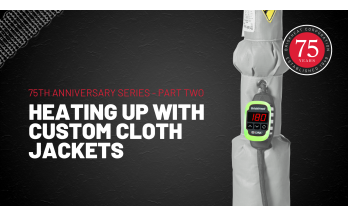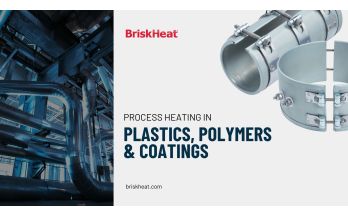Among the applications that can benefit from surface-heating techniques are freeze protection, flow and viscosity control, and process temperature control.
Heat is an important part of many manufacturing and industrial processes. The right surface-heating solution can be used for freeze protection, flow/viscosity control, process temperature control, condensation prevention, container heating or composite repair. There are many heating options to choose from such as heating tapes and cables, silicone heating blankets, cloth-jacket heating systems, container heaters, temperature controllers and composite hot bonders. These heating options can be configured to meet the needs and specifications of even the most precise applications.
The top 6 applications that can benefit from a surface-heating solution include:
1. Freeze Protection
Freeze protection is one of the most popular applications that can benefit from surface heating. Virtually every industry can benefit from taking freeze protection measures at the plant, building or grounds. Self-regulating heating cable or silicone-rubber heating blankets can protect water pipes, valves and tanks from freezing. Roof and gutter heating cable can be installed to prevent snow and ice buildup on structures and over walkways. Common industries that need freeze protection include petrochemical/chemical processing, food processing, pulp and paper, packaging, power generation, water/wastewater treatment, general manufacturing, construction, agriculture and mining.
2. Flow/Viscosity Control
Another common application that requires surface heating is flow or viscosity control. In applications where materials must be heated to reduce viscosity — so they can easily move from one process to another — many heating products may be used. Flow/viscosity control is often a concern in the food processing, petrochemical/chemical and general manufacturing industries. Popular heating solutions for flow and viscosity control include heating cables, tote tank heaters, drum heaters, pail heaters and silicone-rubber heating blankets.
3. Process Temperature Control
Process temperature control is an important part of processing in industries such as plastics and injection molding, concrete, asphalt and general manufacturing. The most common surface-heating application in plastics/injection molding requires melting plastic pellets into a liquid before injecting them into plastic-forming molds. Cloth-jacket heating systems, heating cable and silicone-rubber heating blankets are popular options for this process. In the concrete industry, admixtures stored in drums or tote tanks must be kept warm, and their temperature can be maintained through drum or tote tank heaters. Similarly, asphalt manufacturers must maintain the asphalt’s working temperatures and often use constant-wattage heating cable on pipes and silicone-rubber heating blankets for vessels to achieve the desired temperature.
4. Condensation Prevention
Condensation prevention is a common concern for food processing, coal power generation, semiconductor, flat panel, LCD, LED and photovoltaic/solar industries. Food processing companies need to prevent condensation so food preparation areas are not contaminated. Silicone-rubber heating blankets can be used to create temperature equilibrium, eliminating condensation. In coal power generation, hopper systems are used to capture fly-ash during the burn process. By carefully heating the hoppers with silicone-rubber heating blankets, condensation is prevented, which allows for undisrupted burn processing. Semiconductor, flat panel, LCD, LED and the photovoltaic/solar industries often prefer to use cloth-jacket heating systems on gas delivery, foreline and exhaust pipe lines to prevent condensation that could cause clogging.
5. Container Heating
Container heating options provide space-saving heating solutions to make the industrial processes of materials stored in containers more efficient. Gas handling/processing companies use gas cylinders to store and dispense many types of gas. Gas cylinder warmers can help increase the cylinders’ temperatures and maintain the proper pressure to allow a much higher percent of the gases to dispense. In biodiesel manufacturing, the manufacturer must heat waste-vegetable oil. This typically is heated in 55-gal drums with a drum heater. Other materials stored in pails and totes can be elevated to a certain temperature with the proper pail or tote tank heater.
6. Composite Curing
The aviation, aerospace and marine industries can benefit from composite curing/process temperature maintenance solutions. For smaller repairs, composite repair/strengthening can be done onsite with an out-of-autoclave curing solution using hot bonders and heating blankets. Out-of-autoclave heating system technology is capable of providing precise and uniform temperature control on composite surface areas. Full-size autoclaves remain an option for much larger composite repairs.





